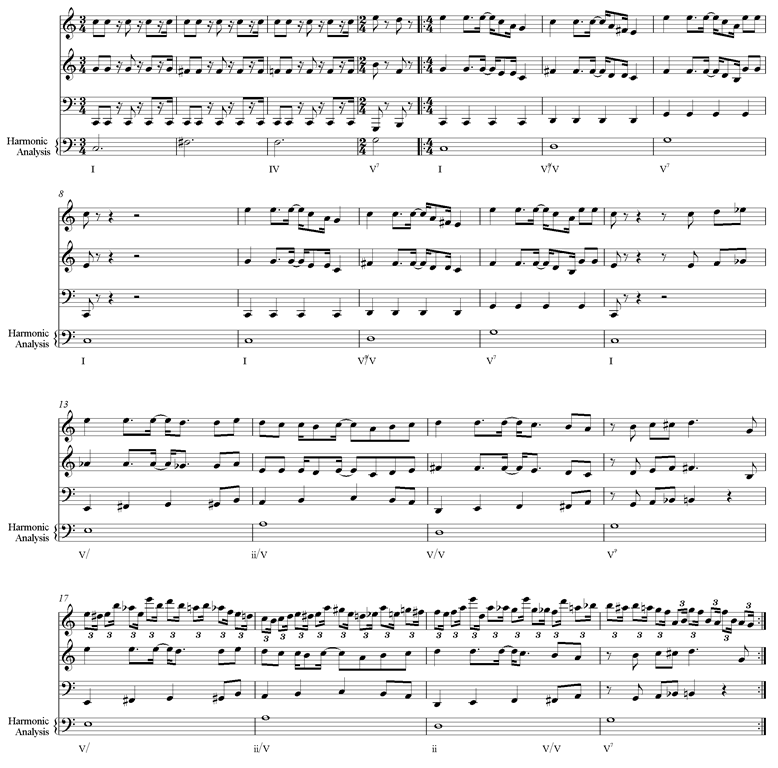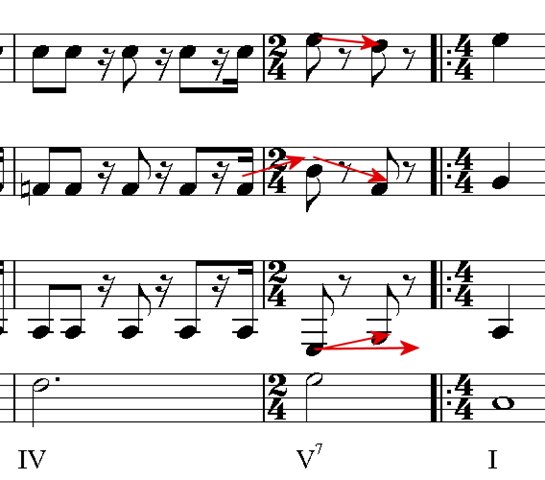In continuing with my analysis of Super Mario Bros. 2, let us now turn to the Character Select music.
This bouncy little tune is an interesting study in voice leading. With only three lines of pitch available to the composers of NES tunes, there comes a big challenge with voice leading and doubling within the parts. They can, however, use the limited number of vertical pitches to phase in and out of different harmonic implications.
In this score, the bottom staff represents the implied bass line and contains a harmonic analysis. Only the upper three lines are the pitches of the music object. They will be referred to as Soprano, Alto, and Bass throughout the analysis.
For an example of the voice leading/doubling challenge, lets take a look at the fourth measure. Here sits a typical V7 chord that is desiring to go to the tonic. The soprano line uses a classical ornamental figure of an appoggiatura to add variety to the line. The intrigue here is in the alto line. Coming out of the descending chromatic line, the alto briefly jumps up to a B before jumping back down to the F.
It was important for Kondo to create the sense of dominant on the downbeat of the fourth measure. To do that, especially after the chromatic passing motion in measure two, he had to establish the interval of a major third over the bass note G. This allows the appoggiatura to be effective, ensuring E does not belong in the chord. Had he stayed on the F (as one might do if there were four parts involved), the pitches on the downbeat would be E, F, and G. Though the outline of the dominant seventh is there, it lacks the tonal pull of the leading tone B which defines the function of this harmony.
However, Kondo wanted to maintain the pitch framework from the opening three measures in the measures following. You will notice that measure 1-3 contains the alto pitches G, F#, and F. These are also the pitches in measures 5-7. To get back to the G, without leaving the leading tone hanging in measure F, Kondo frustrated the B back down to the F (seventh of the chord) to which then rises back to G. To make up for the missing third, the bass jumps up to provide the leading tone. This is effective because the bass note G will ring in our inner-ear throughout the measure until replaced by the root of the tonic chord.
The other interesting area of this music object occurs at the end. The form of the object is as follows (each section is four measures long):
Into-(A-A-B-B’)
The two A sections are identical in every respect. The B sections is built on this idea, however, the second section includes an obbligato soprano line which bounces all over the pitch spectrum. Though harmonically they function identically, Kondo plays with the alternation of F and F# between these two phases creating different qualities of the harmony. Though the circle of fifths progression is still the same, its qualities are colored by this chromatic alteration.
For example, m.16 is a dominant harmony, but the use of the F# in the alto line moves us into a b minor sonority briefly, or perhaps a GMM7. However, the obbligato firmly plants us on a V7 chord in m.20.
Likewise, m.15 uses a V/V to introduce the dominant chord, but this V/V starts as a ii in m.19 due to the fluctuation of this pitch.
Too bad when the game is actually being played that this music is rarely heard completely.


2 comments:
Thank you so much for doing what you do. It's the music of video games that keeps my interest in harmonic analysis and theory alive and thriving. Keep up the great work.
Thank you very much Christopher. I'm glad you found me here. I hope that by taking a more indepth look at Video Game music do just that. I'll be back with more updates very soon!
Post a Comment